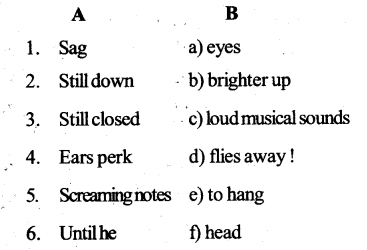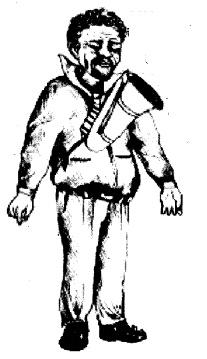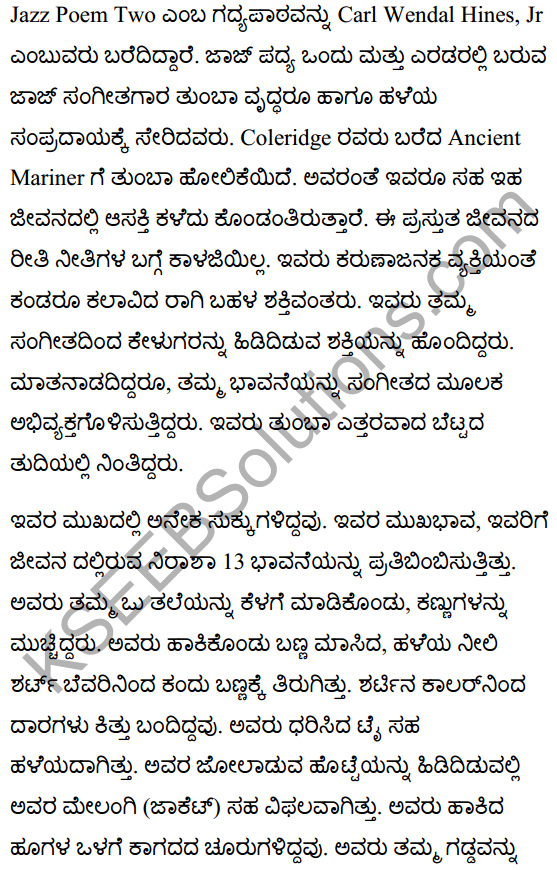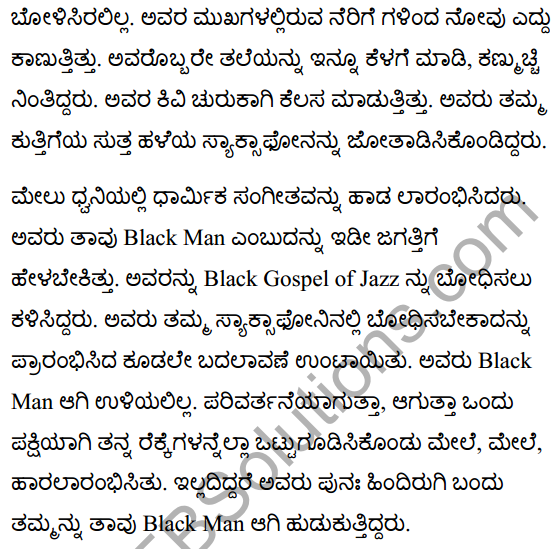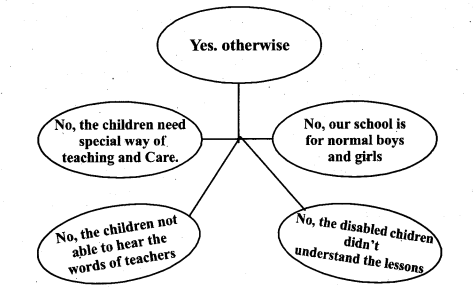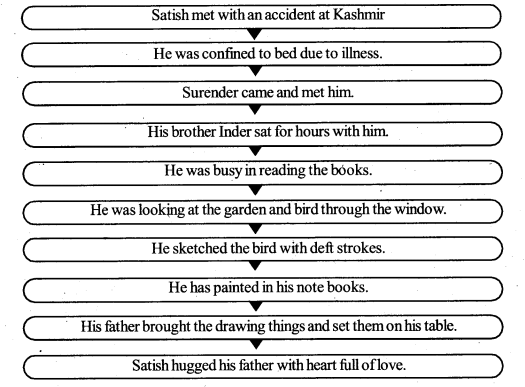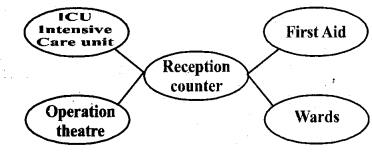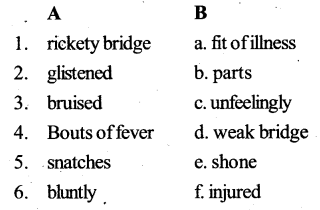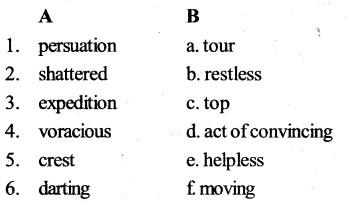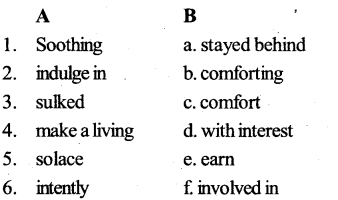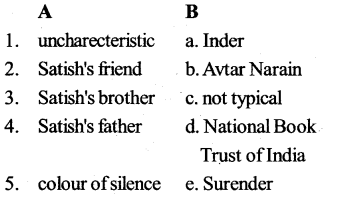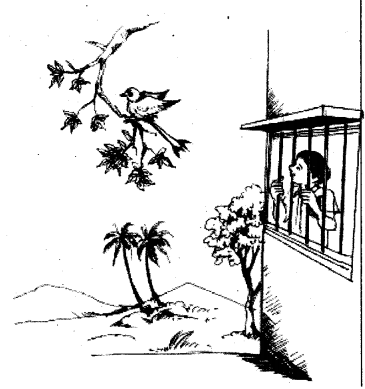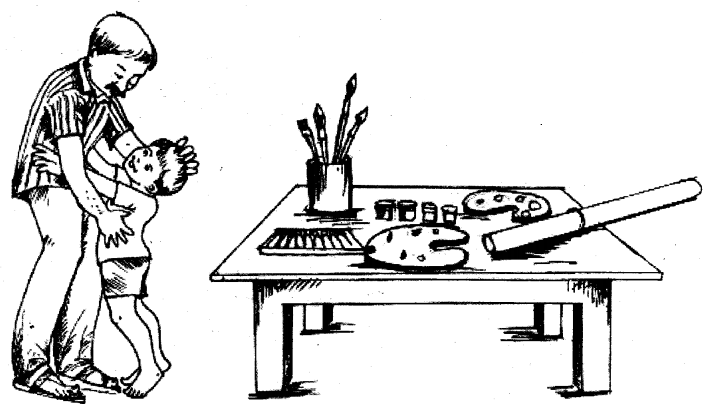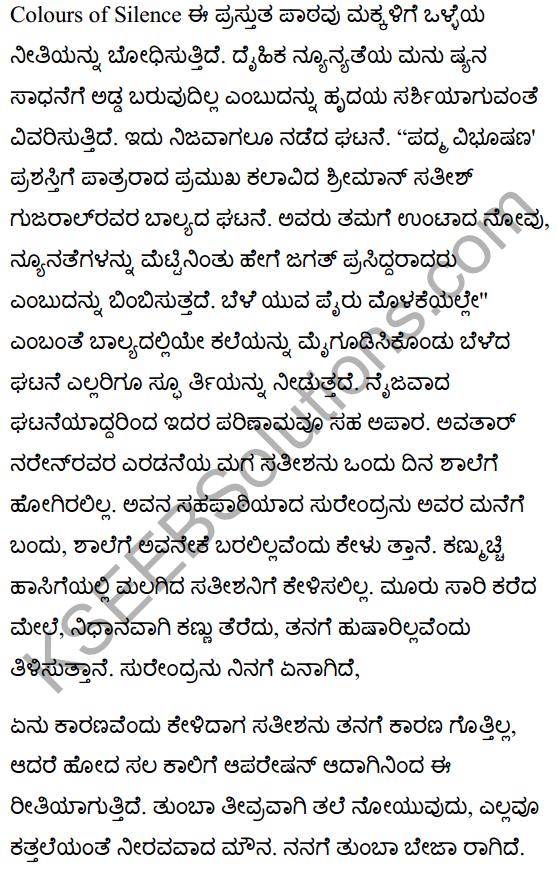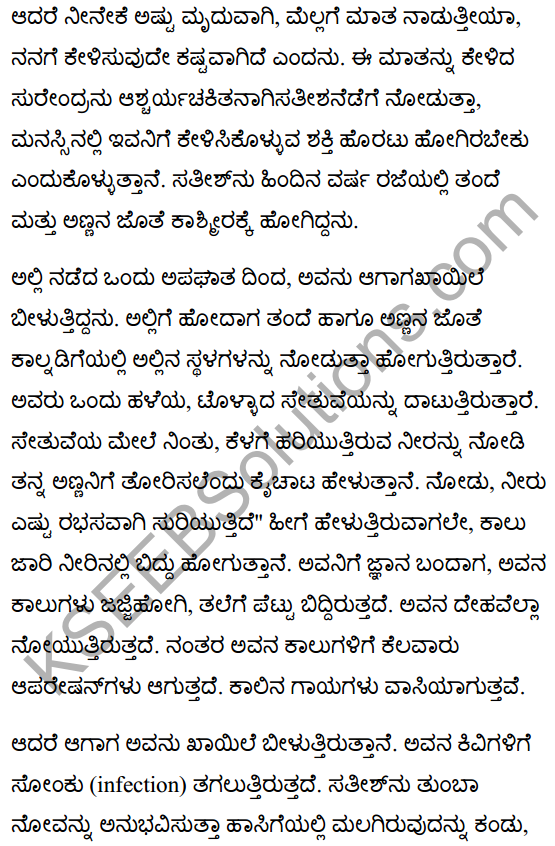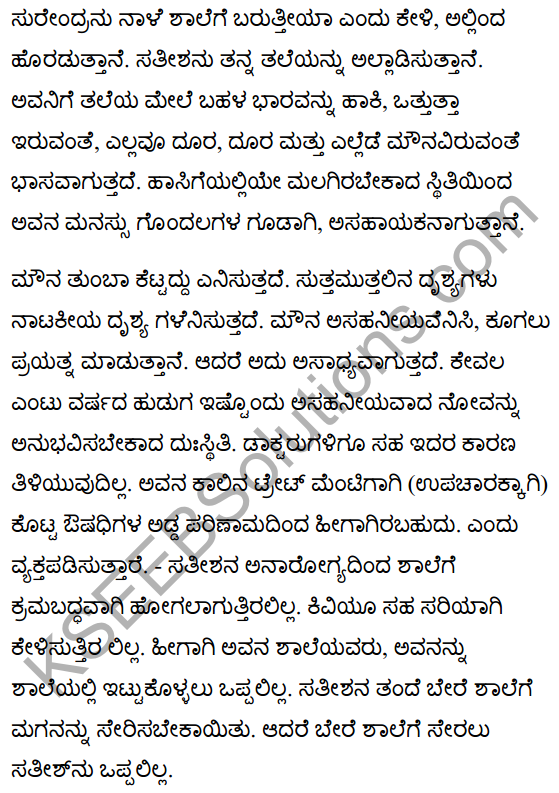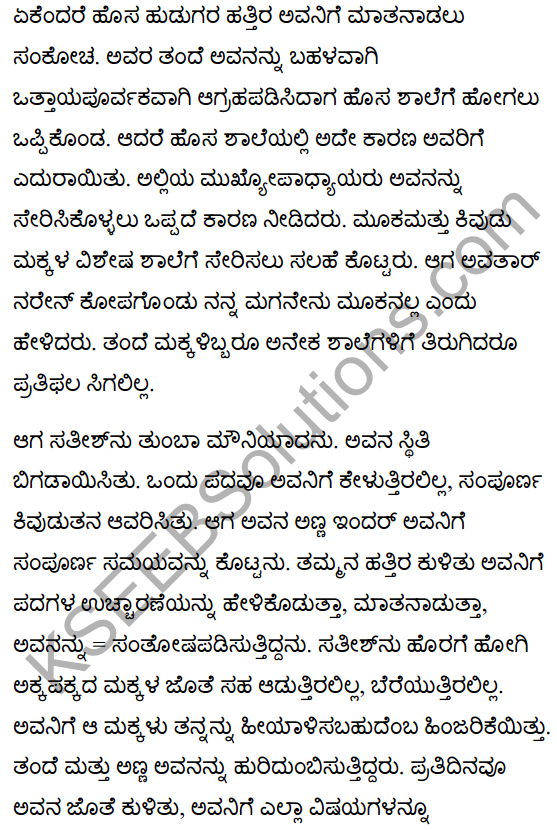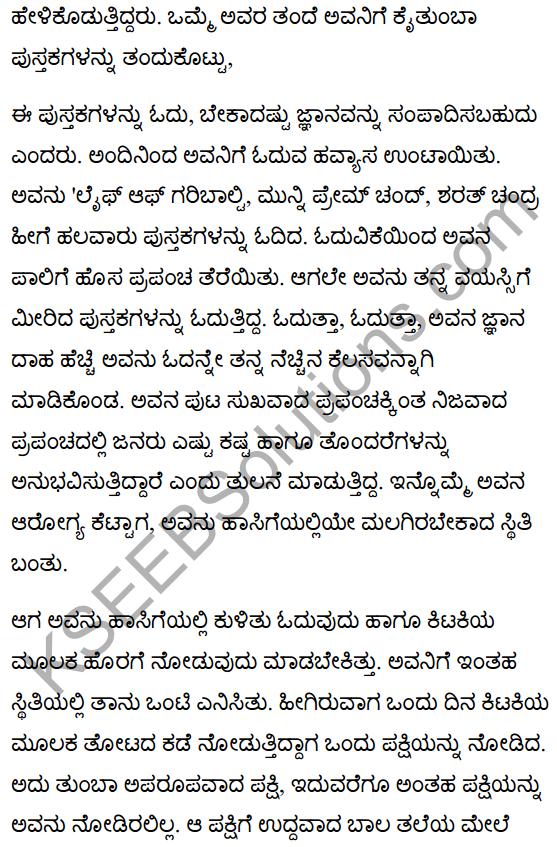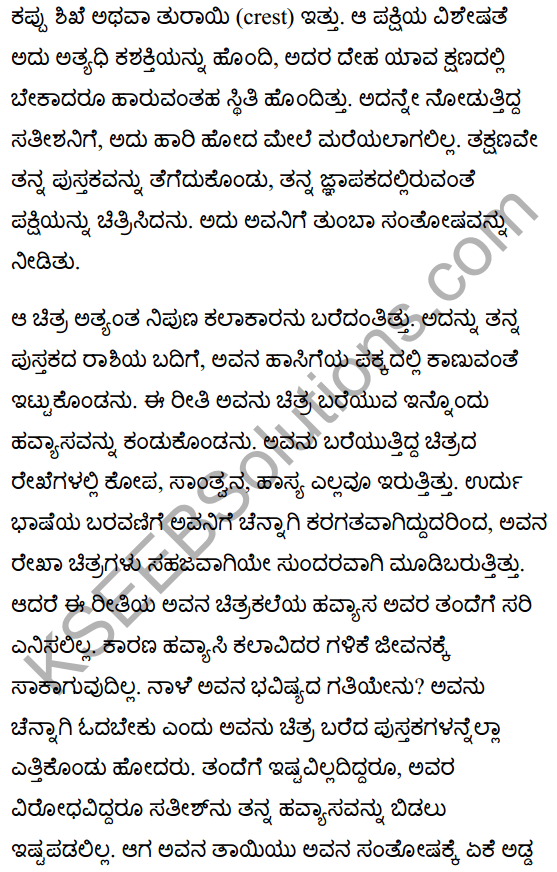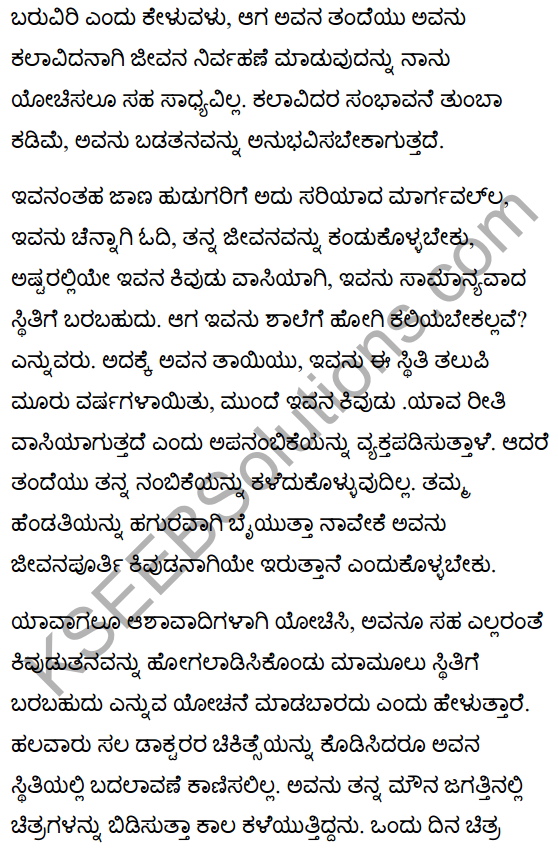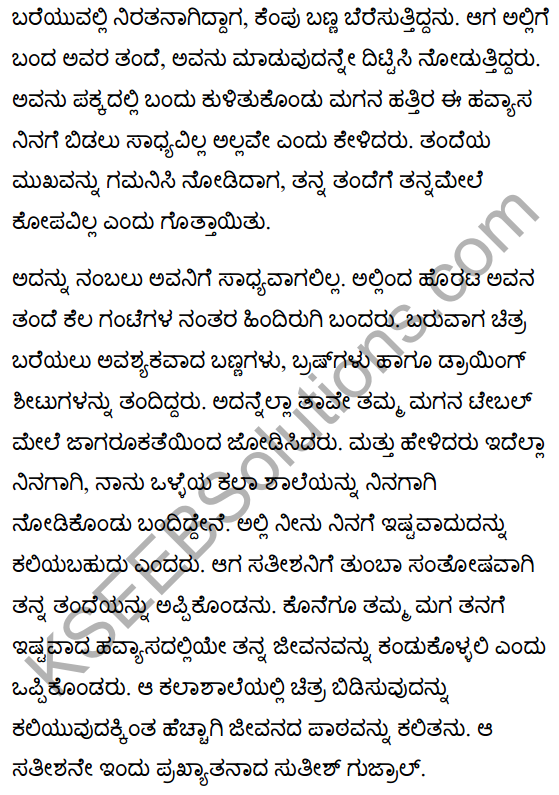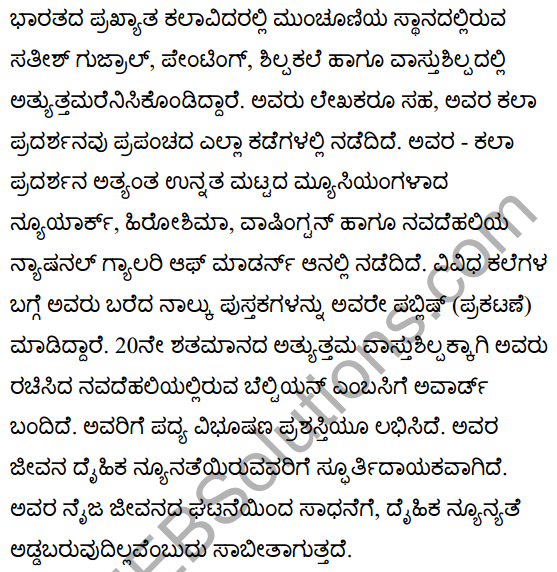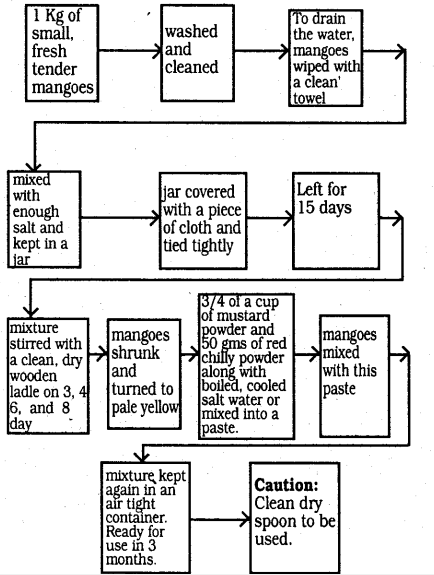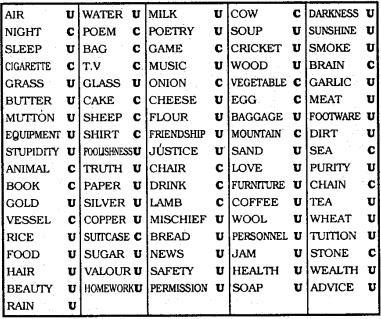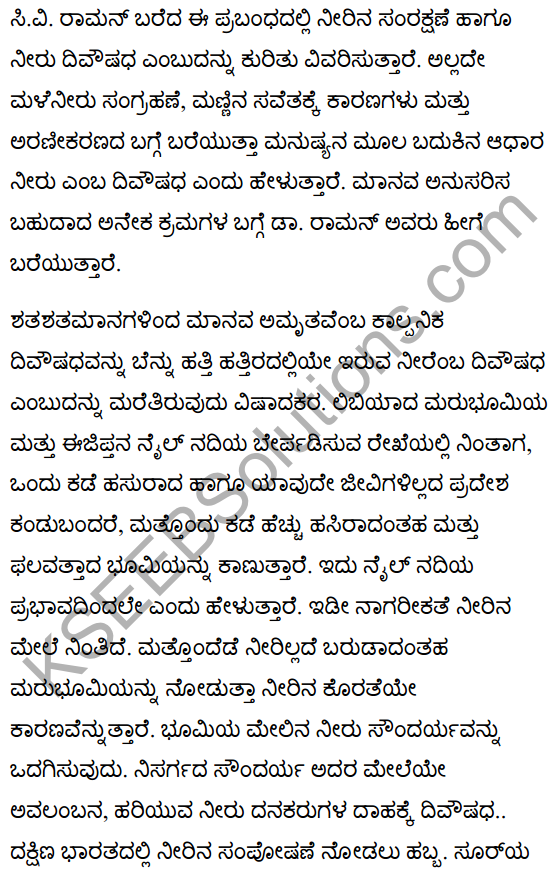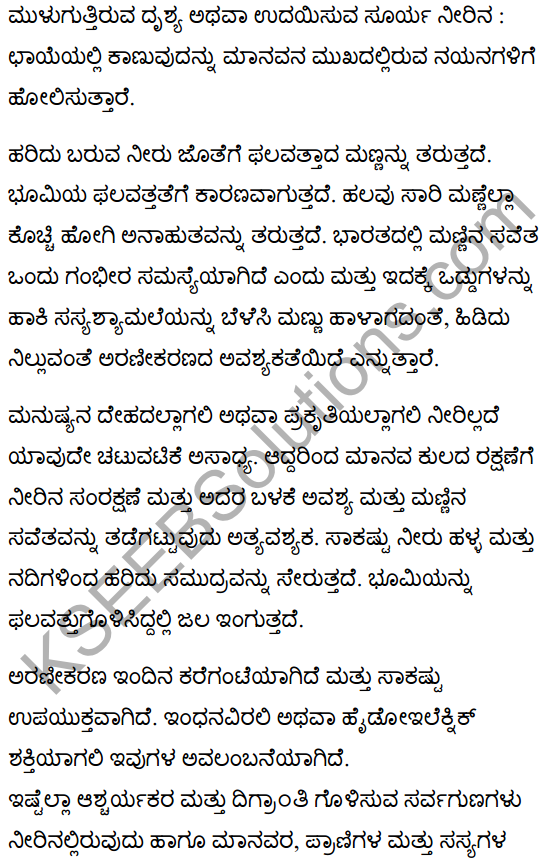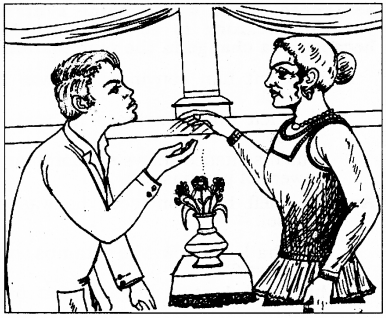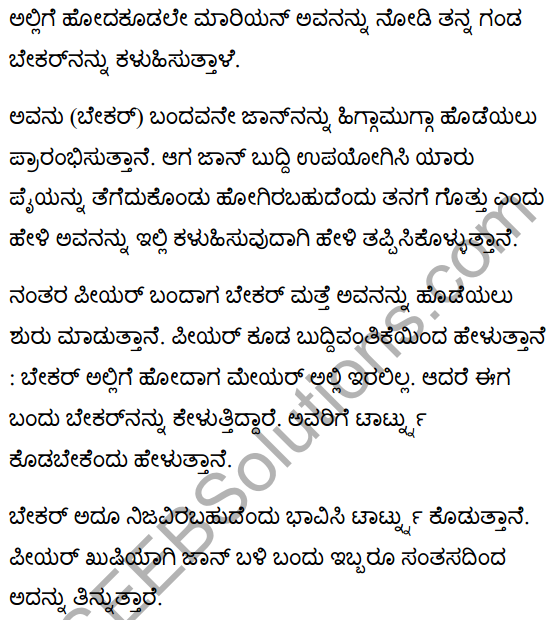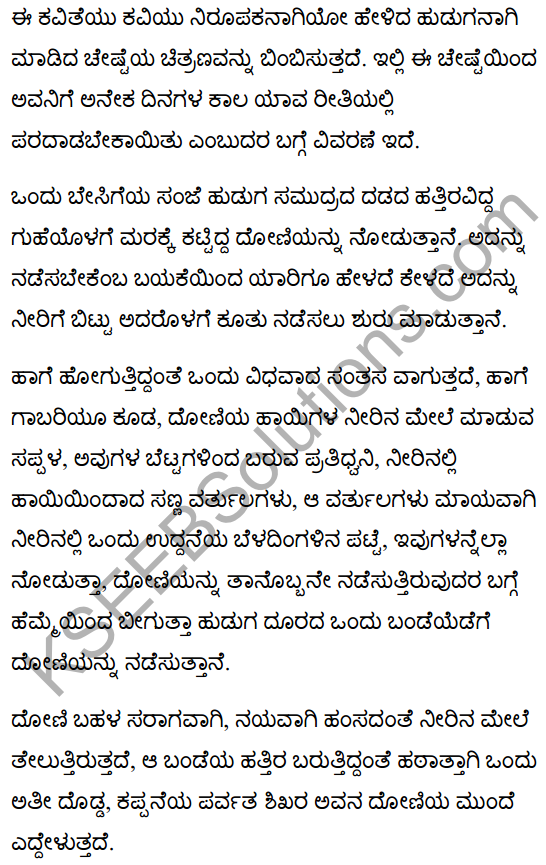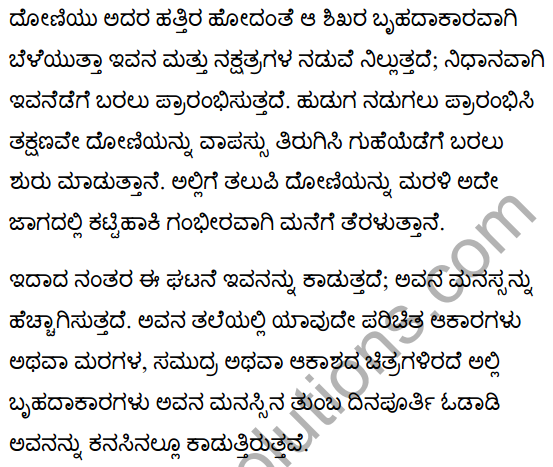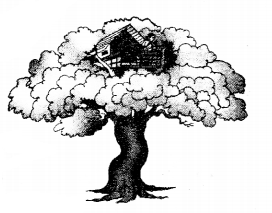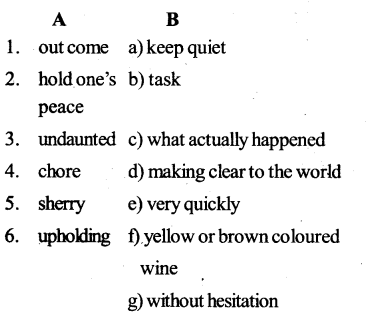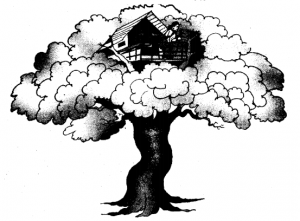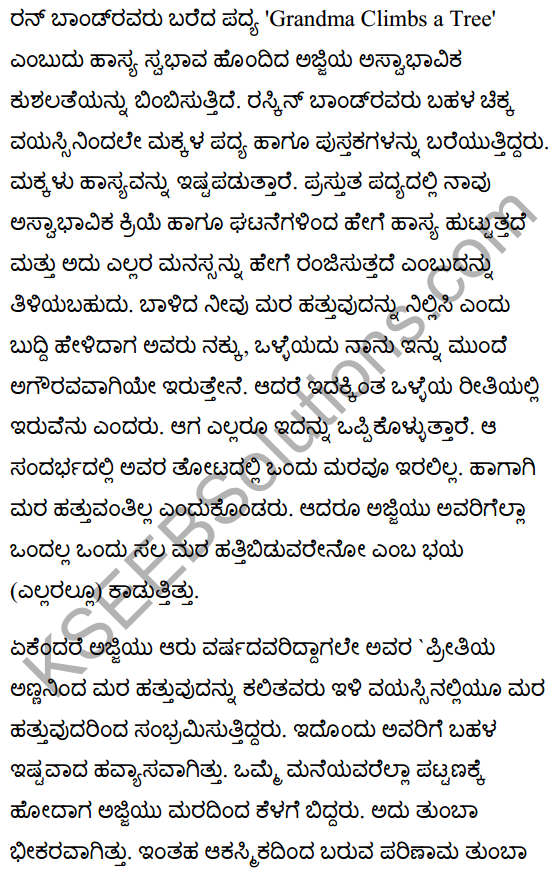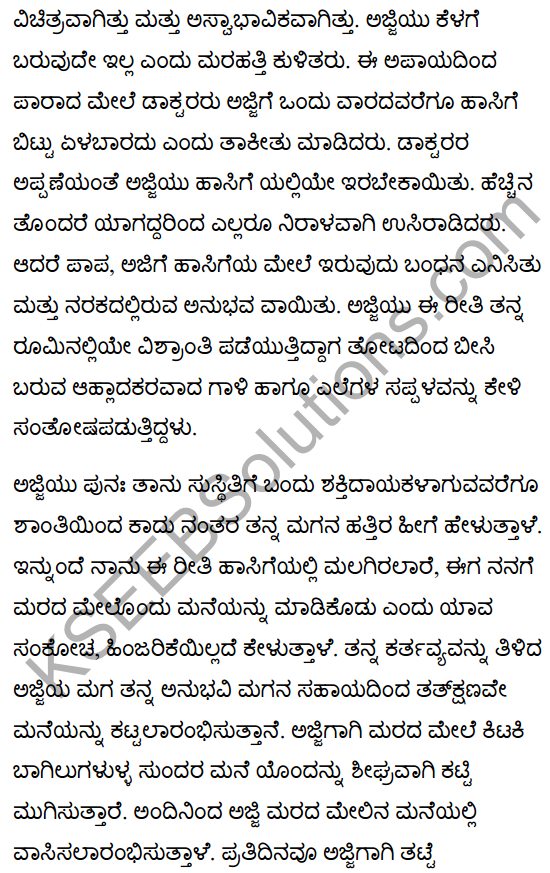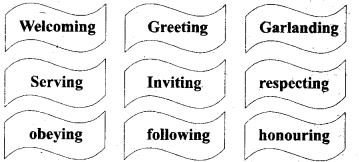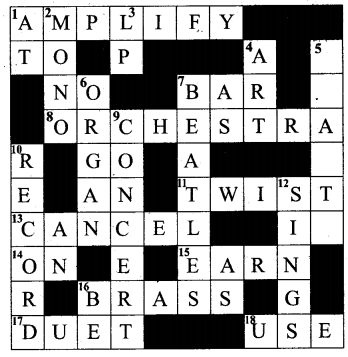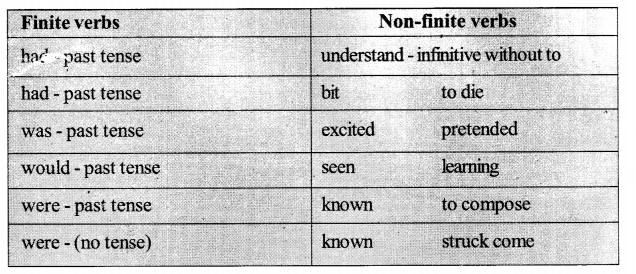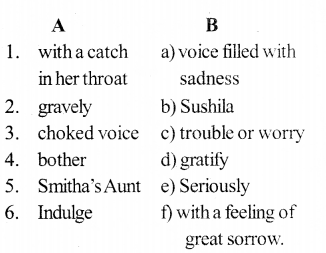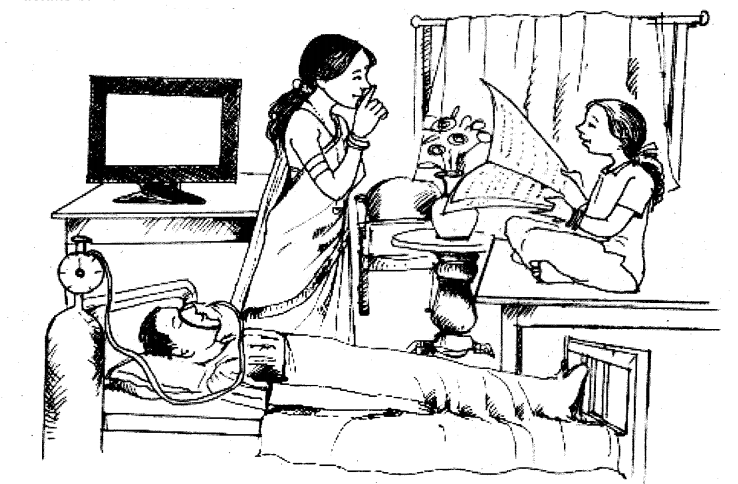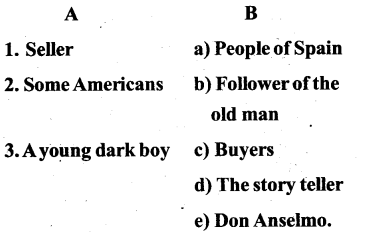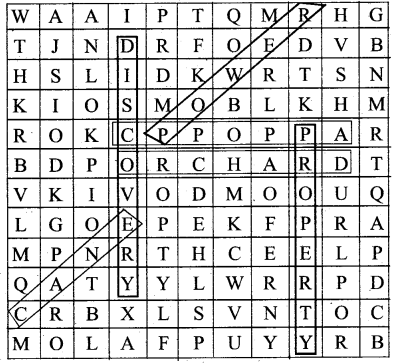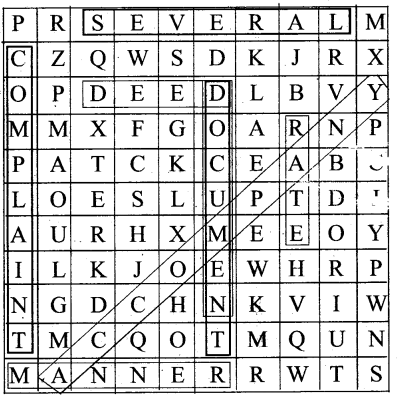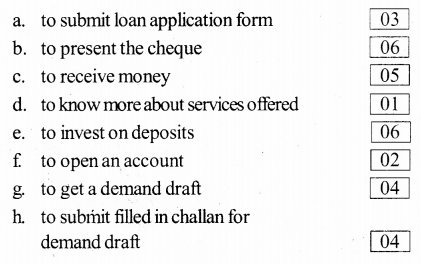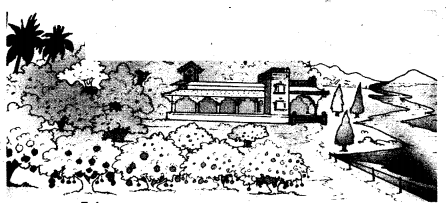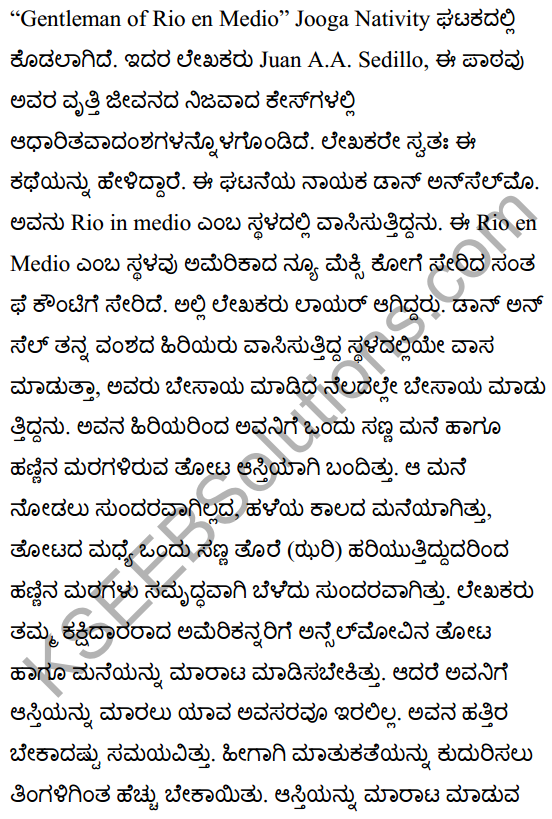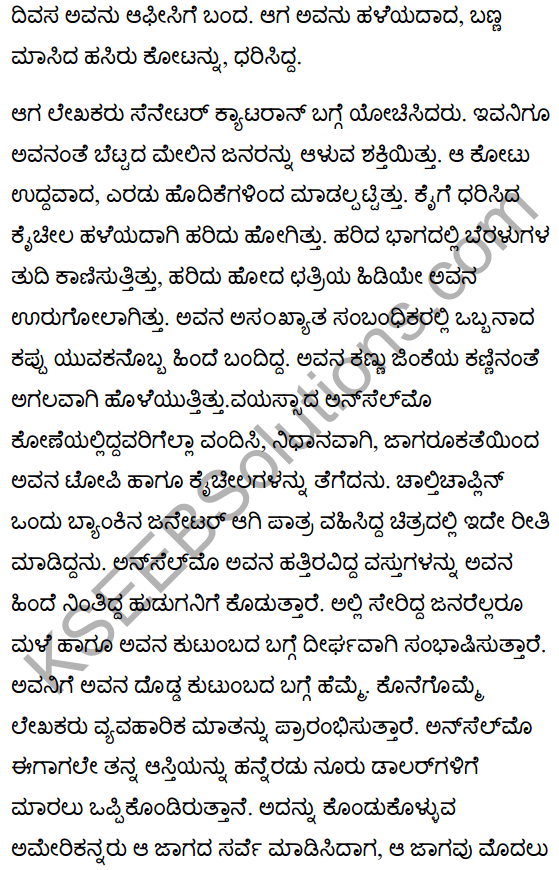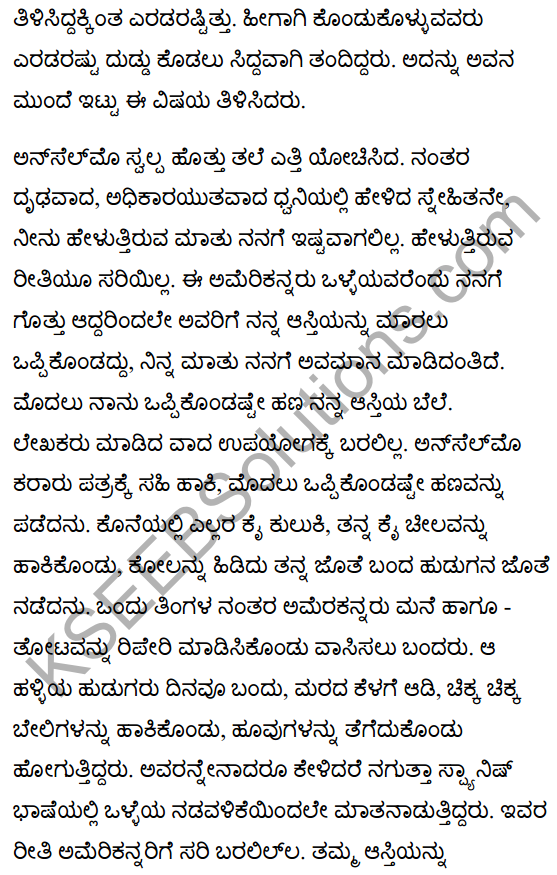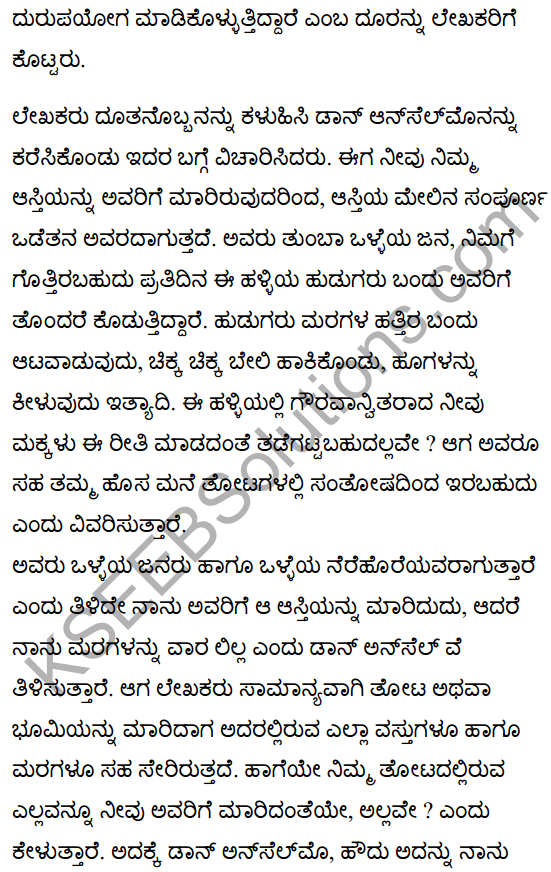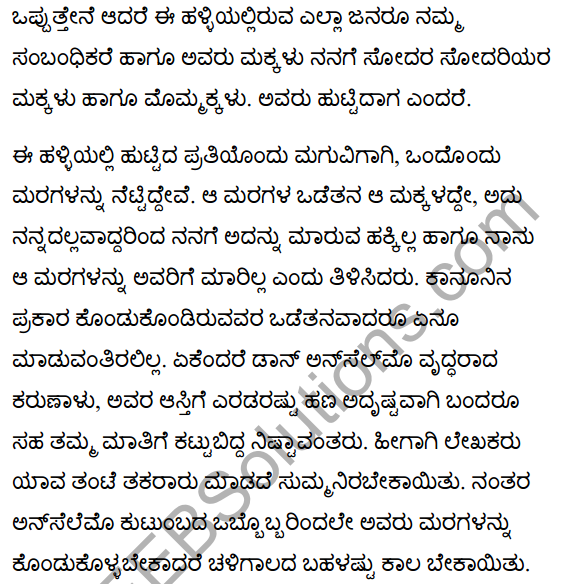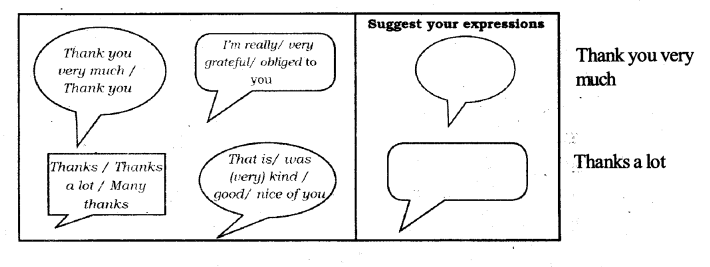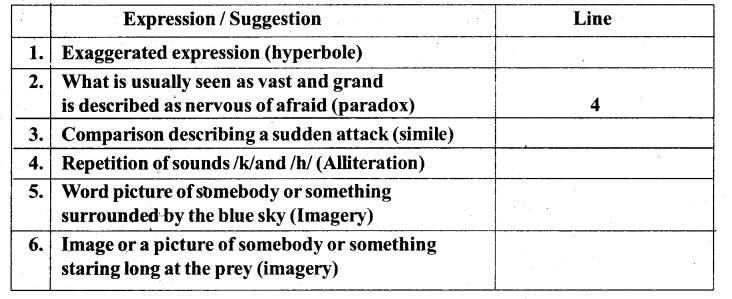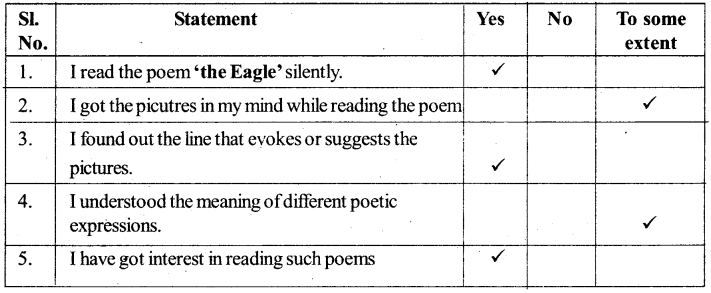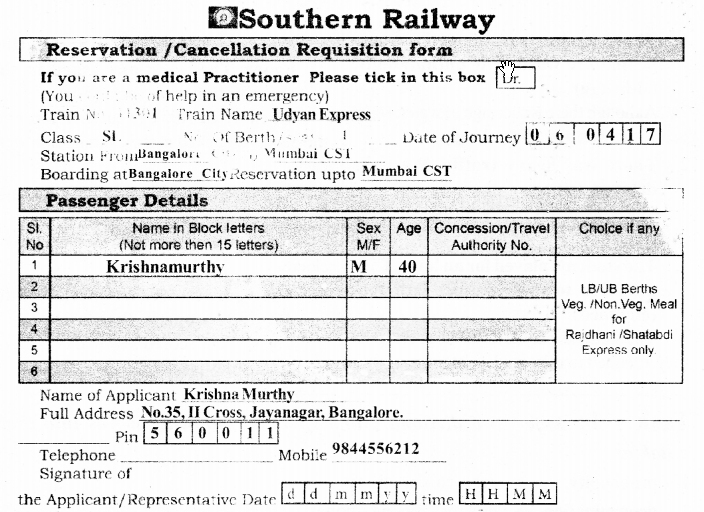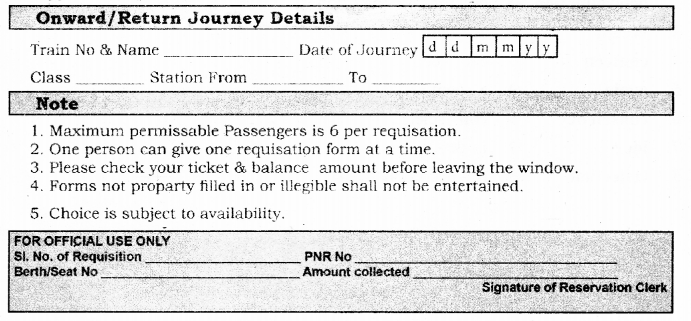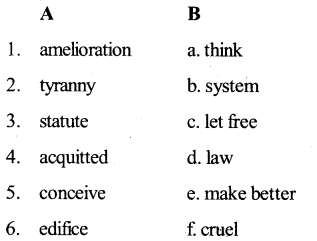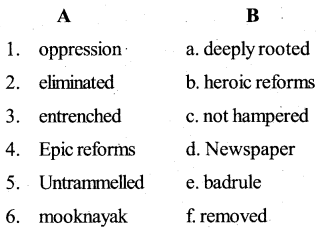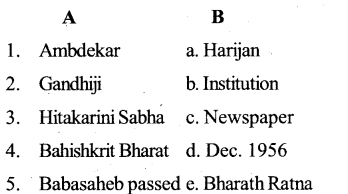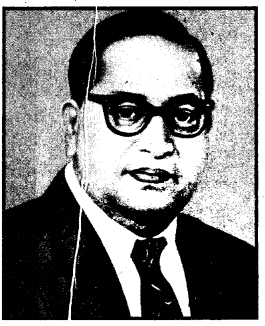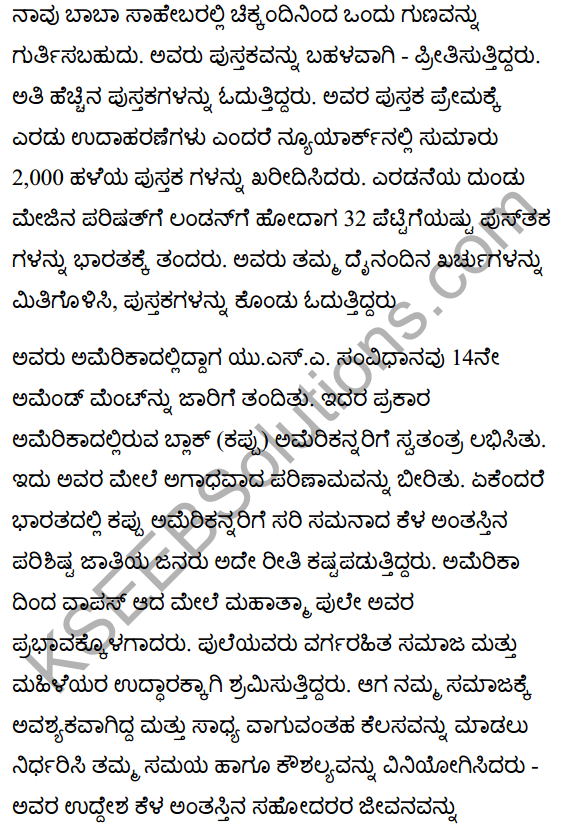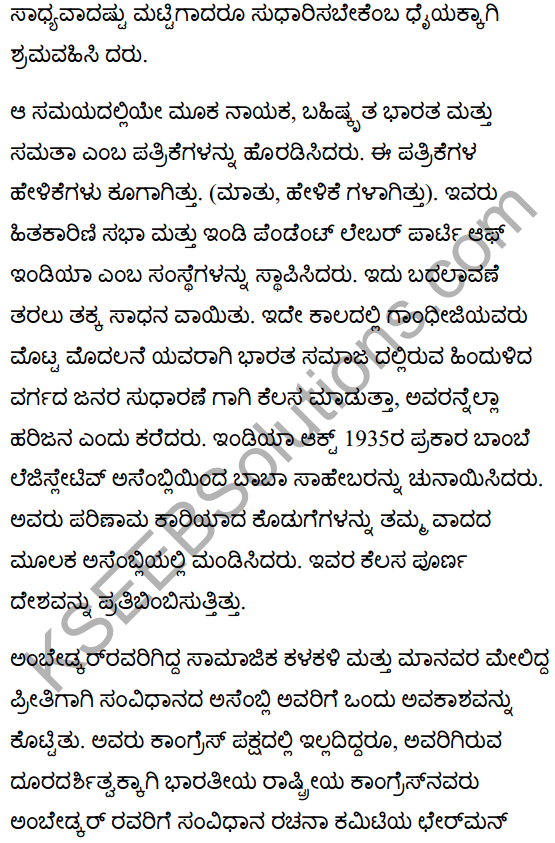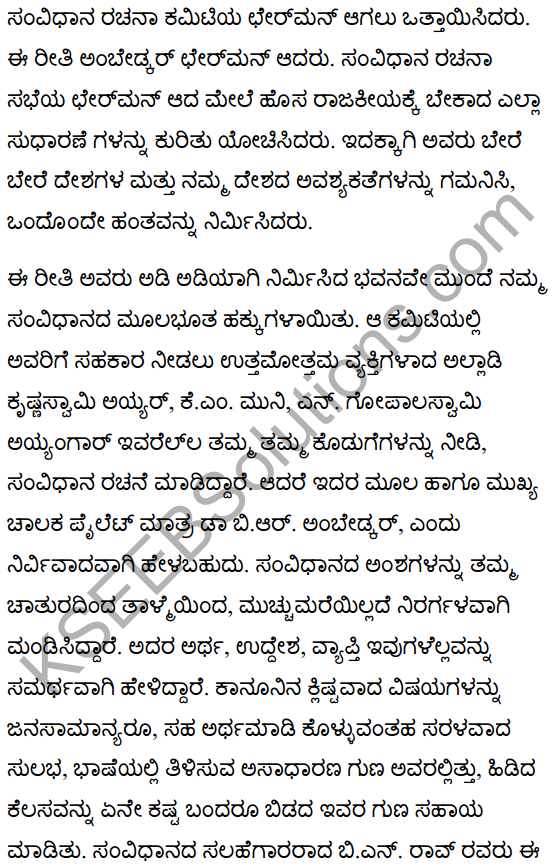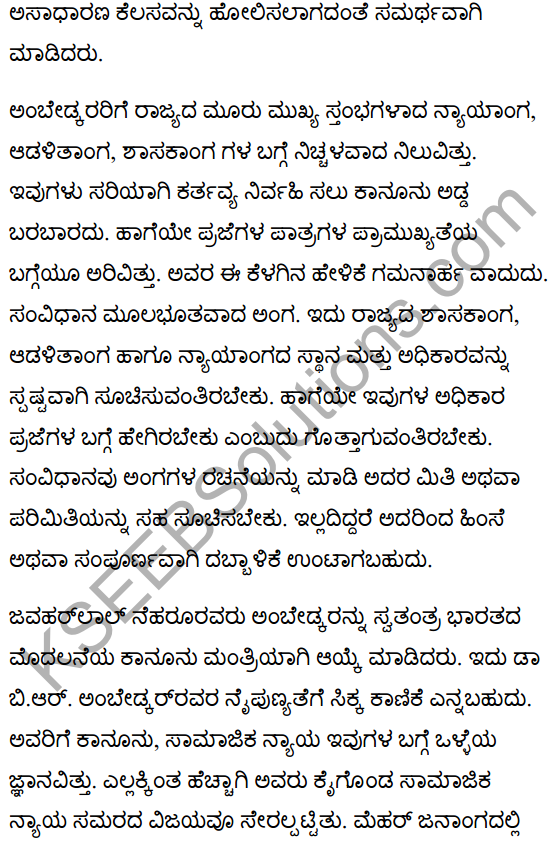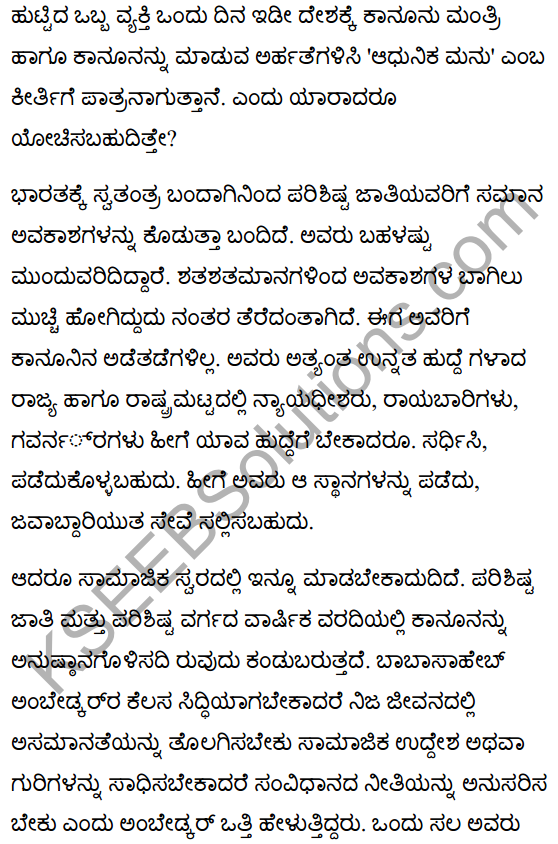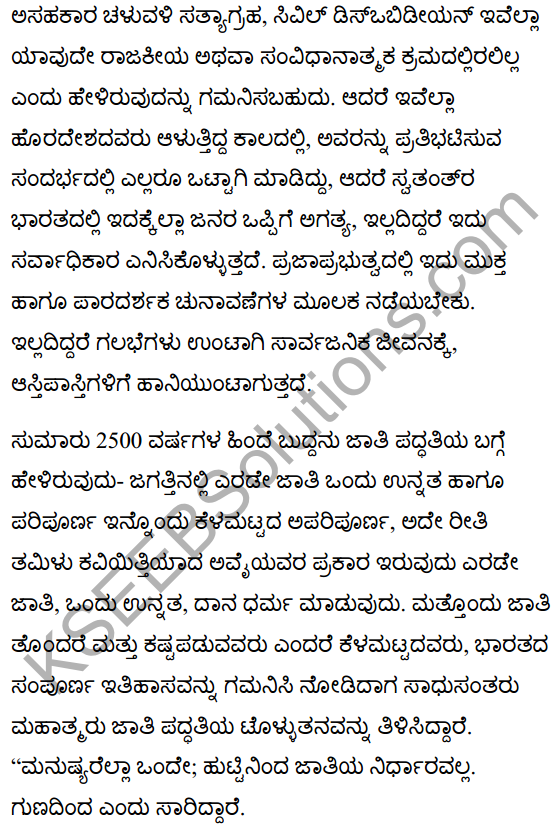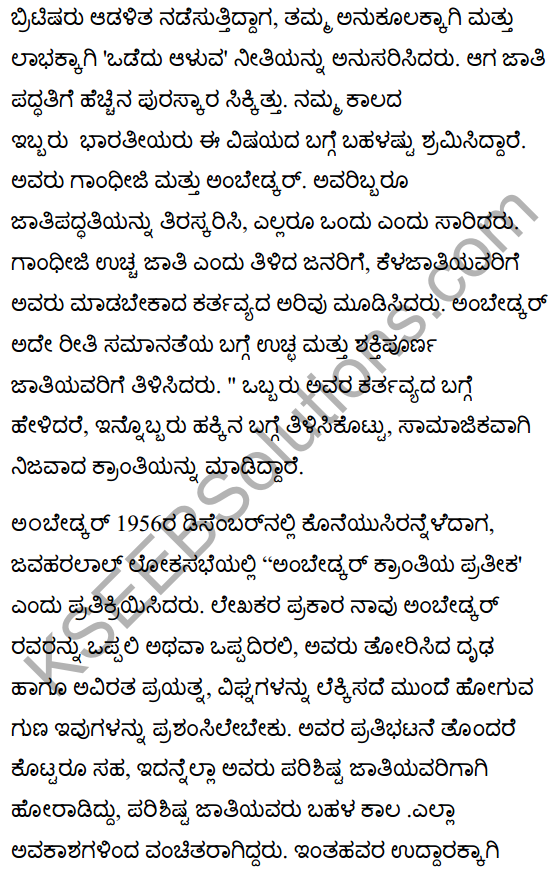Every chapter available in the KSEEB SSLC Class 10 English Solutions subject is explained clearly in an easy way. Learn the depth concept by referring to the Chapter wise Louis Pasteur, Conqueror of Disease Questions and Answers Pdf, Notes, Summary Class 10 English Karnataka State Board Solutions. Have a look at every topic and get the complete knowledge on the English subject. Just refer to Karnataka Class 10 English Chapter 4 Louis Pasteur, Conqueror of Disease pdf and have a grip on the total subject.
Louis Pasteur, Conqueror of Disease Questions and Answers, Notes, Summary
I believe that the best book is like a best friend to know the complete world by sitting in one place. When you have the best book you have many options to get great knowledge. Selecting the best book will lead to reaching your goal. Students who are looking for the best book to learn English can use Karnataka Board Solutions for Class 10 English Chapter 4 Louis Pasteur, Conqueror of Disease. Immediately start your learning with Karnataka Board Class 10 English Solutions Pdf.
Comprehension Questions
I. Answer the following questions briefly:
Louis Pasteur Conqueror Of Disease KSEEB Soltuion Question 1.
“Louis Pasteur was not a soldier, but he was a fighter.” What does the statement mean?
Answer:
Though Louis Pasteur did not join the army and become a soldier, he was a fighter because he fought various kinds of diseases through his discoveries about bacteria.
Louis Pasteur Conqueror Of Disease Notes KSEEB Soltuion Question 2.
What are bacteria?
Answer:
Bacteria are vegetable organisms – little rod shaped plants which exist in the air, water and soil, and in the bodies of animals and plants; some but not all are the causes of diseases; some convert matter into food for plants.
KSEEB Soltuion For Class 10 English Louis Pasteur Question 3.
As a scientist, how was Louis Pasteur unique ?
Answer:
Louis Pasteur not only made some exciting discoveries about germs but he was also able to use his discoveries in very practical ways. He could help many people running various industries in France.
Louis Pasteur Notes KSEEB Soltuion Question 4.
How did Pasteur try to solve difficult problems?
Answer:
Pasteur used to sit for hours, quite silent and motionless, thinking hard about the difficult problems.
Louis Pasteur Lesson Notes KSEEB Soltuion Question 5.
- How would Pasteur react whenever he solved a problem?
- What does this reveal about him as a person?
Answers:
- When he thought of a solution, his kind, a tired looking face would brighten with pleasure and excitement, and he would rush round to tell his discovery to his wife and to others who were helping him.
- This shows that Pasteur was sincere about solving problems and was also very simple and child-like in sharing his discoveries with others.
Louis Pasteur Conqueror Of Disease Summary KSEEB Soltuion Question 6.
What discoveries did Pasteur make about yeast?
Answer:
Yeast is used to making the beer foam. Pasteur discovered that yeast was alive, made up of tiny living cells. When these cells were healthy, the yeast acted well, but if they were diseased, the yeast and the beer went wrong.
Louis Pasteur Conqueror Of Disease Question And Answer KSEEB Soltuion Question 7.
What does ‘spontaneous generation’ mean?
Answer:
Some scientists believed in ‘spontaneous generation’, i.e., they believed that germs had no parents but just occurred by themselves.
Louis Pasteur KSEEB Soltuion Question 8.
Did Pasteur believe in Spontaneous generation? If not, what did he believe in?
Answer:
Pasteur and some scientists like him believed that germs were carried in the air and might infect other things that came in contact with them.
Louis Pasteur Question Answers Class 10 KSEEB Soltuion Question 9.
In the statement, “Pasteur proved that he was right” (Para 9), What did he prove?
Answer:
Pasteur proved that germs were carried in the air and might infect other things that came in contact with them.
KSEEB Louis Pasteur Solutions Question 10.
In the second soup experiment (para 10) which soup was the worst, which was the best and which one was better?
Answer:
In the second soup experiment, the bottles opened in the hotel bedroom were full of soup which had gone completely mouldy due to the presence of many germs; the bottles opened in the field were mouldy, but not quite so bad; those opened on the mountain had no germs in them at all. The last batch was the best, the first one was worst, and the second one better than the first one.
Louis Pasteur The Conqueror Of Disease KSEEB Soltuion Question 11.
What is Pasteurization?
Answer:
Pasteurization is the process of heating the wine or milk of any other liquid to a temperature of 50 to 60 degrees centigrade to make the germs harmless. Pasteurized milk is milk which has been treated in this way and then sealed to prevent more germs from entering.
Louis Pasteur Questions And Answers KSEEB Soltuion Question 12.
The writer says,” It would be impossible to imagine Pasteur experimenting with explosives or poisonous gas” (para 13). What quality of Pasteur is highlighted here?
Answer:
Pasteur’s love for mankind and his compassionate nature are highlighted in the sentence. He had no love for plain achievement, money or fame.
Question 13.
On what study did Pasteur spend all his time and energy for three years?
Answer:
For three years, Pasteur spent all his time and energy in tracking down the cause of a disease which had ruined the silkworm industry.
Question 14.
How is vaccination different from inoculation?
Answer:
Introducing live organisms into the body to generate immunity is vaccination (for viral diseases like small pox, rubella, chicken-pox, measles, tuberculosis) whereas introduction of weak or dead organisms into the body to produce immunity is called inoculation (for bacterial diseases like typhoid, diphtheria and cholera).
Question 15.
What made Pasteur believe that a cow could not have anthrax twice?
Answer:
When Pasteur was trying to discover a cure for the terrible disease called ‘Anthrax’, he found out, first of all, that a cow could not have Anthrax twice.
Question 16.
What made many scientists angry? (para 16)
Answer:
Pasteur began to wonder whether it would not be possible to make a cow and even a man just a little ill with Anthrax so that they might not get it again. He thought that this could be done by giving the cows or sheep very weak old germs to make them safe or immune for the future. This idea of giving animals germs made many scientists angry.
Question 17.
What is rabies?
Answer:
Rabies is a dangerous disease of dogs and other mammals, caused by a virus that can be transmitted through the saliva to humans, causing madness and convulsions.
Question 18.
How was Pasteur a better scientist than Jenner?
Answer:
Although Dr. Jenner had already discovered how to vaccinate against smallpox, he did not really understand about bacteria. Pasteur after giving his life to this study was able to prove the value of inoculation and to find out ways of varying it for different diseases.
Question 19.
How was the very low death rate among the troops during the First World War a great tribute to Pasteur’s work?
Answer:
During the First World War 1 (1914-1918), the troops going abroad were » inoculated against such diseases as typhoid and enteric fever, and the very low death-rate from this illness among v the troops, even in unhealthy places, was a great tribute to Pasteur’s work.
Question 20.
At the opening ceremony of Pasteur Institute in Paris, Pasteur talked about two opposing laws.
- Which are the two laws?
- Which one did he favor?
Answers:
- One law was a law of blood and death, opening out each day new methods of destruction, forcing nations to be always ready for the battle; I the second law was a law of peace, work, and health, whose only aim is to deliver f man from the disasters which surrounded I him. The first one seeks violent conquests, j the other relief of mankind.
- Pasteur favored the second law I of peace, work, and health because he was sure that science in obeying the law of humanity, will always labor to enlarge the frontiers of life.
Question 21.
What was his message to young students on the occasion of his 70th birthday celebration?
Answer:
His message was: “First ask yourselves, ‘What have I done for my education?’ Then as you advance in life, What have I done for my country?’ so that someday that supreme happiness may come to you, the consciousness of having contributed in some measure to the progress and welfare of humanity.”
Question 22.
What is the supreme happiness he talks about?
Answer:
He says supreme happiness is the result of the consciousness of having contributed in some measure to the progress and welfare of humanity.
Question 23.
Here are Louis Pasteur’s thoughts at various points in the lesson. Read the paragraphs mentioned against each and explain how he came to each conclusion.
a. I am certain that yeast is alive, made up of tiny living cells (para 7) ______
Answer:
While helping the brewer, Pasteur learned many things about yeast. He observed that yeast was alive, made up of tiny living cells. When these cells were healthy, the yeast acted well, but if they were diseased, the yeast and the beer went wrong.
b. Germs are carried in the air and may ______ infect other things that came in contact ______ with them, (para 8, 9)
Answer:
As Director of Scientific Studies at a famous college in Paris, Pasteur was thinking about decay and yeast and germs. He believed that germs were carried in the air and infected other things that came in contact with them. He proved this point by pulling out the neck of soup bottles so that there was a big bend in the middle. The soup in the bottle never went bad because there were no parent germs in the soup and no germs could reach it because of the bend in the long tube. It was only when a little soup was split down the tube that germs entered it with dust and infected it.
c. Pure air is different from stale air (para 10) ______
Answer:
Pasteur filled some bottles with soup. He took some into a little hotel bedroom where the air was hardly ever changed, broke their necks off so that the air could enter freely, and after a few minutes sealed them up again. He then took’ some bottles into a field nearby and did the same with them. Finally, he opened some on the top of a high mountain and again sealed them up. When they were examined, the bottles opened in the hotel bedroom were full of soup which had gone completely moldy; the bottles opened in the field were moldy, but, not quite so bad; those opened on the mountain had no germs in them at all.
d. Pasteurization makes the germs harmless, (para 12) ________
Answer:
Pasteur showed that by heating the wine or milk or whatever it might be to a temperature of 50 or 60 degrees centigrade, the germs were made harmless.
II. Close Study :
Read the following extracts carefully. Discuss in pairs and then write the answers to the questions given below them
Question 1.
‘Do germs form from other germs, or do they just come of themselves?’
a) What did people like Pasteur actually believe about germs?
Answer:
People like Pasteur believed that germs were carried in the air and might infect other things that came in contact with them.
b) Which of the two was called ‘spontaneous generation’?
Answer:
Scientists other than Pasteur believed in ‘spontaneous generation’, i.e., they believed that germs had no parents but just occurred by themselves.
c) How did Pasteur prove that he was right?
Answer:
Pasteur proved that he was right by conducting an experiment in which the neck of a bottle with the soup was extended to step germs from entering. Only when the soup was poured into this bend, it came in contact with germs from dust and got infected.
Question 2.
‘If you can cure animals, you can cure my son’.
a) What had Pasteur cured the animals off?
Answer:
Pasteur had cured the animals of the terrible disease of Anthrax.
b) What was wrong with the ‘son’ referred to?
Answer:
The boy was covered with bites from a mad dog and was sure to die.
c) Did Pasteur cure the boy? How?
Answer:
Pasteur inoculated the boy with some weak rabies germs and the boy recovered.
III. Paragraph Writing :
Discuss in pairs/groups of 4 each, the answers to the following questions. Individually, note down the important points for each question and then
develop the points into one paragraph answers:
Question 1.
What was troubling the French wine-growers? How did Pasteur solve their problem? What is the name of the process which was the solution to the wine-growers?
Answer:
- French wine-growers troubled by a germ.
- Pasteur showed how to render these germs harmless.
- This process was called ‘Pasteurization’.
Paragraph: Some French wine growers were troubled by a germ which had turned their wine sour. Pasteur showed that by heating the wine to a temperature of 50 or 60 degrees centigrade, the germs were made harmless. This process was called ‘Pasteurization’.
Question 2.
How did Pasteur develop the idea of immunity?
Answer:
- Pasteur busy in discovering cure of Anthrax.
- He found that a cow could not get it twice.
- He thought of giving weak old germs to make beings safe from Anthrax.
Paragraph: Pasteur was trying to discover a cure for the terrible disease called Anthrax, which men sometimes get from infected shaving brushes, and which was attacking cows and sheep in France and killing them off very quickly. He found out first of all that a cow could not have anthrax twice. Then he began to wonder whether it would not be possible to make a cow and even a man just a little ill with anthrax so that they might not get it again. Perhaps this could be done by giving the cows or sheep very weak old germs to make them safe or ‘immune’ for the future.
Question 3.
What human qualities of Pasteur do you admire?
Answer:
- All of Pasteur’s work was meant to help human beings.
- He was genuinely interested in ’ others’ problems.
- He was child-like and simple by nature.
Paragraph: Louis Pasteur was what we should call an ‘all round’ scientist. All the research which he did in his laboratories was meant to help his fellow human beings. It would be impossible to imagine Pasteur experimenting with explosives or poison gas. Pasteur was genuinely interested in solving the problems of others. He would ponder for a long time, and when finally he found a solution, he would run to convey his idea to the others. Pasteur was child-like and very simple by nature. When there was a storm of applause in the big medical Congress in London, he looked around thinking that the cheers must be for some royal person and not himself at all.
Question 4.
“All the research which he did in his laboratories was meant to help his fellow human beings”. Elucidate.
Answer:
- Pasteur discovered many things about germs and also used that knowledge well. ‘
- He worked hard in his laboratories to help people in specific problems.
- He discovered ‘inoculation’.
Paragraph: Pasteur not only made some exciting discoveries about germs but he was also able to use his discoveries in very practical ways. He worked hard in his laboratory with test tubes and all kinds of experiments, but nearly all the time he was working to help people who were suffering in some special way from the disease. Among the people whom Pasteur was able to help were brewers, breeders of silk works, and cowkeepers, all of whom were trying to carry on important industries in France. He discovered ‘inoculation’ which provided immunity to people and animals against anthrax and also the dreaded disease, rabies.
Question 5.
What would have been the fate of humankind if Louis Pasteur had not discovered a vaccine against rabies?
Answer:
- Rabies is a dangerous disease.
- Many people used to die of rabies.
- Pasteur inoculated an infected boy.
Paragraph: Rabies is a dangerous disease of dogs and other mammals, caused by a virus that can be transmitted through the saliva to humans, causing madness and convulsions. Many people used to die of rabies. Many others used to suffer from bites caused by a mad dog. Pasteur inoculated an infected boy with some weak rabies germs and the boy recovered. This turned the fate of rabies-infected people.
IV. Vocabulary Exercises
A. Fill in the blanks with the opposites of the words underlined.
Questions
- The machines are busy but they are ________ now because there is no electricity.
- Some of the students were interested in the lesson while the rest were _________ in it.
- We have appointed a new manager because the previous one was ___________
- To maintain one’s health one should eat food that is fresh, not _________
- Someone dropped a burning cigarette on the carpet and that was the cause of the fire. The __________ was that the whole building was burned down.
- The wounded tiger attacked the hunter and he was unable to __________ himself.
- Our army has checked the enemy’s advance, and they have no other option but to ___________
- There is a progressive improvement in the school’s results since 2006, thank God it is not _________.
Answers:
- idle
- uninterested
- dismissed
- stale
- result
- defend
- retreat
- regressive/declining.
B. Discuss in pairs the difference between the words in each pair. Frame sentences to bring out the
difference.
- bravery × boldness
- quite × quiet
- infectious × contagious
- clever × intelligent
- further × farther
- discovery × invention
- vaccination× inoculation
- due to × owing to
- little × a little
- between × among
Answers:
- Bravery: When the dog saved its owner from drowning in the river, everyone appreciated its bravery.
Boldness: When the politician came to her doorstep asking for votes, the woman showed boldness by asking him some crucial questions. - Quite: We can all rest at his bungalow as it is quite big.
Quiet: Please be quiet. I want to hear the announcement. - Infectious: Although the joke wasn’t very funny, her infectious laughter made all of us burst into laughter.
Contagious: Cures for many contagious diseases were found in the 20th century. - Clever: The clever crow dropped pebbles into the pot to make the water come up to the brim.
Intelligent: Birbal was intelligent enough to give solutions to Akbar every time Akbar faced a problem. - Further: I do not want any further argument about this topic.
Farther: We had walked farther than we wanted to. - Discovery: Pasteur discovered that germs were everywhere, in the air, water and soil.
Invention: Edison invented the bulb. - Vaccination: Introducing live organisms into the body to generate immunity is vaccination.
Inoculation: Introduction of weak or dead organisms into the body to produce immunity is called inoculation. - Due to: The roads were flooded due to rain.
Owing to: Owing to his mistake, the accounts had to be checked all over again. - Little: Can you give me some water? There is little water in my bottle.
A little: Only a little is known about the writer of this novel. Let us try to know more. - Between: Both of them shared the cake equally between them.
Among: He tried to sow hatred among the people.
C. Here are some lines from the lesson that tell us about Louis Pasteur. Identify quality. You can choose the right word from the ones given in the box.
| modest, risk-taker, altruistic, idealistic, trustworthy, pacifist, untiring, persuasive. |
Questions:
- nearly all the time he was working to help people who were suffering in some special way from disease’
- Pasteur proved that he was right -about germs being carried in the air.
- It would be impossible to imagine Pasteur experimenting with explosives or poison gas.
- For three years he spent all his time and energy in tracking down the cause of a disease which had ruined the silkworm industry.
- One can imagine how dangerous this idea of giving people the germs must have seemed in those days.
- He looked around, thinking that the cheers must be for some royal person.
- The boy’s mother told Pasteur, ‘If you can cure animals, you can cure my son.
- “ that science is obeying the law of humanity will always labor to enlarge the frontiers of life.”
Answers:
- Altruistic
- persuasive
- pacifist English
- untiring
- risk-taker
- trustworthy
- idealistic.
D. Choose the correct one-word medical terms from the box to the following:
| euthanasia, rhinologist, anatomy, autopsy, ophthalmology, physiognomy, asphyxia, antidote, pathologist, epidemic, oculist, amnesia, congenital, anesthetic, urologist, gerontologist, pediatrics, amputate, panacea, convalescence |
Questions:
- The science that deals with the diseases of children.
- One who treats eye diseases
- Science of the diseases of the eye
- One who treats the diseases of the nose
- One who treats the diseases of kidneys
- A disease that attacks many people at the same time.
- To cut off a part of a person’s infected body
- One who studies the nature and origin of diseases
- The science of the structure of the human body.
- The study of the human face / the art of judging character from the human face.
- The medicine that produces insensibility.
- Loss of memory.
- Fainting or death due to being deprived of air.
- The examination of a dead body.
- A disease or weakness belonging to one by birth.
- A remedy for all diseases.
- Killing a person (with an incurable disease) without pain.
- Gradual recovery from illness.
- One who studies the diseases of old age
- The medicine is given to counteract poison.
Answers:
- pediatrics
- oculist
- Ophthalmology
- Rhinologist
- Urologist
- epidemic
- amputate
- Pathologist
- Anatomy
- physiognomy
- Anaesthetic
- amnesia
- asphyxia
- autopsy
- Congenital.
- Panacea
- euthanasia
- convalescence
- gerontologist
- antidote.
V. Language Activities
A. Change the following into passive sentences.
Question 1.
One manufacturer consulted Pasteur about his beer which was turning out badly.
Answer:
Pasteur was consulted by one manufacturer about his beer which was turning out badly.
Question 2.
Many believed that germs had spontaneous generation.
Answer:
It was believed by many that germs had spontaneous generation.
Question 3.
A simple and clever experiment proved that Pasteur was right about germs.
Answer:
Pasteur was proved right about germs by a simple and clever experiment.
Question 4.
A germ which had turned their wine sour troubled some French winemakers.
Answer:
Some French winemakers were troubled by a germ which had turned . their wine sour.
Question 5.
Dr. Jenner in England had already discovered vaccination for smallpox.
Answer:
Vaccination for smallpox had already been discovered by Dr. Jenner in England.
Question 6.
Pasteur found out first of all that a cow could not have Anthrax twice.
Answer:
It was found out by Pasteur, first of all, that anthrax could not be had by a cow twice.
Question 7.
When the news spread that Pasteur had discovered a cure for anthrax, hundreds of people wrote to him for supplies of ‘vaccine’.
Answer:
When the news was spread that a cure for anthrax had been discovered by Pasteur, letters were written to him by hundreds of people for
supplies of ‘vaccine’.
Question 8.
Pasteur inoculated the young boy with some weak rabies germs.
Answer:
The young boy was inoculated with some weak rabies germs by Pasteur.
B. Imagine that you took your grandfather to the doctor and you heard the following conversation. Now report the same to your father.
- Grandfather: Doctor, I have a terrible p£fin in my chest.
- Doctor: Well, lie down. I need to check your B.P. and listen to your heartbeat.
- Grandfather: Is there any serious problem doctor?
- Doctor: I cannot say anything right now. You need to get an ECG done immediately.
Answer:
Grandfather informed the doctor that he had terrible pain in his chest. The doctor listened to him and asked him to lie down. He said that he needed to check grandfather’s B.P. and listen to his heartbeat. Grandfather became anxious and asked whether there was any serious problem. The doctor replied that he could not say anything right then. He wanted grandfather to get an ECG done immediately.
C. Which disease?
Study the following example:
Facts about Typhoid
- Medical name: Enteric Fever
- Causes: Ingestion of contaminated food or water.
- Symptoms: high fever, headache, stomach pain, exhaustion, poor appetite.
- Treatment: Antibiotics
- Diet: Easily digestible bland food, plenty of fluids.
- Duration of illness: r4-6 weeks
- Recovery Period: 7-10 days
- Relapse: Common
In pairs, make an information chart like the one above about another common disease you know.
Answer:
Facts about ‘Malaria’, :
- Medical name? Malaria
- Causes: Female Anopheles mosquito bite.
- Symptoms: rigor, cold, fever during the night
- Treatment: Antimalarial drug known as ‘quinine’.
- Diet: Easily digestible bland food, plenty of fluids.
- Duration of illness: 2-3 weeks
- Recovery Period: 20—30 days
- Relapse: Possible.
D. Parts of the body such as ‘head’, ‘eye’, ‘nose’ etc. can also be used as verbs.
Eg.:
- Dr. Arvind heads the group of doctors at Manipal Hospital.
- That man has been eyeing your suitcase. Be careful.
- She nosed the car into the traffic.
Now, use the following parts of the body as verbs in sentences. You may look up a dictionary for help. Do it in pairs.
- elbow
- hand
- knee
- toe
- teeth
- knuckle
- shoulder
- thumb
- face
- mouth
Answers:
- Elbow : (move forward pushing others with the elbows).
He elbowed his way to the front of the crowd in order to have a better look at the actor. - Hand : (give)
The boss handed me my promotion letter. - Knee: (hit with the knee)
Kneeing football is more difficult than dribbling. - Toe : (follow)
In a multinational organization, all employees have to toe the official line. - Teeth: (grow new teeth)
The baby is teething. She is suffering from a lot of pain. - Knuckle: (apply oneself seriously to a task)
After many false starts, he finally knuckled down to the job. - Shoulder: (take over)
After his father’s death, Ramesh shouldered the responsibility of educating his brothers. - Thumb: (shuffle through)
While waiting for the guest to arrive, I thumbed through the magazine, - Face : (confront, deal with)
We faced many problems while trying to correct social tong. - Mouth: (utter insincerely)
The friends of the actor mouthed their condolences on the death of his father and left for their work.
E. The following sentences contain wrong collocations. The wrong words have been underlined. Correct the sentences using the appropriate collocations.
Question 1.
She had her ears poked when she was just one year old.
Answer:
pierced
Question 2.
The victims were charred to death in the fire.
Answer:
burnt/charred to death
Question 3.
In summer, I need to have my hair chopped short.
Answer:
cut / cropped
Question 4.
It is the bus driver who committed the accident.
Answer:
caused
Question 5.
Rice production needs to be enhanced.
Answer:
increased / augmented
Question 6.
Teacher: I shall not engage my class tomorrow.
Answer:
(The underlined word is correct)
Question 7.
Fish are reared on a commercial scale.
Answer:
bred
Question 8.
He speaks chaste Kannada.
Answer:
(The word underlined is correct)
Question 9.
She is a far relation of mine.
Answer:
distant
Question 10.
Parking facilities have been scraped on Ashoka Pillar Road.
Answer:
Scrapped
VI. Grammar Revisited
Rewrite the following as directed:
Question 1.
He was too old to learn new things (use ‘so ……… that’)
Answer:
He was so old that he could not learn new things.
Question 2.
He is not tall enough to touch the ceiling (use ‘too… to’)
Answer:
He is too short to touch the ceiling.
Question 3.
If they were not brave they would have lost the battle, (use ‘but for’)
Answer:
But for their bravery, they would have lost the battle.
Question 4.
Had she been wise I should not have – opposed her. (use ‘if)
Answer:
If she had been wise, I would not have opposed her.
Question 5.
You are a great fool, (change into an exclamation)
Answer:
What a fool you are!
Question 6.
Bring it here, (change into a polite request)
Answer:
Please bring it here.
Question 7.
It is raining, (change into a probability)
Answer:
It may rain today.
Question 8.
I want to be a millionaire, (express it as a wish beginning your answer with,’ I wish ’)
Answer:
I wish I were a millionaire.
Question 9.
As soon as we reached the station the train left, (use ‘No sooner’)
Answer:
No sooner did we reach the station than the train left.
Question 10.
As soon as they reached the playground it began to rain, (use ‘Hardly’)
Answer:
Hardly did they reach the playground when it began to rain.
Question 11.
She ran away so that she should not be married, (use ‘lest)
Answer:
She ran away lest she should be married.
Question 12.
If you don’t walk fast, you will miss the train, (use ‘otherwise)
Answer:
You should walk fast, otherwise, you will miss the train.
Question 13.
Besides being intelligent she is hardworking, (use ‘not only…but)
Answer:
She is not only intelligent but also hardworking.
Question 14.
In spite of his riches, he is unhappy, (use ‘nevertheless)
Answer:
He is rich. Nevertheless, he is unhappy.
Question 15.
To avoid punishment you must apologize, (use ‘or)
Answer:
You must apologize or you will be punished.
Question 16.
Did you see any other person at the party? (use ‘else)
Answer:
Did you see anyone else at the party?
Question 17.
He earned a lot but he became greedier, (use ‘the more)
Answer:
The more he earned, the greedier he became.
Question 18.
He told them to come early, (use ‘suggested)
Answer:
He suggested that they come early.
Question 19.
I forbid you the use of my laptop, (use ‘mustn’t)
Answer:
You mustn’t use my laptop.
Question 20.
Let’s try to do it the other way. (use ‘How about)
Answer:
How about trying to do it the other way?
Question 21.
It would be advisable to start early, (use ‘had better)
Answer:
We had better start early.
Question 22.
Shall I go home early this afternoon? (use ‘would you mind)
Answer:
Would you mind permitting me to go her early this afternoon?
Question 23.
I am sorry to inform you that your son has failed, (use ‘I’m afraid)
Answer:
I’m afraid your son has failed.
Question 24.
I am sorry I don’t know how to do it. (begin with ‘I wish ’)
Answer:
I wish I knew how to do it.
Question 25.
I prefer to stay at home, (use ‘would rather)
Answer:
I would rather stay at home.
Question 26.
We hid behind some bushes so that the enemy should not see us. (use ‘for fear’)
Answer:
We hid behind some bushes for fear of being seen by the enemy.
Question 27.
The dog is the best friend of man. (change using ‘good’)
Answer:
There is no other friend of man as good as a dog.
Question 28.
Darjeeling is more beautiful than many other hill stations in India, (change using ‘as….as’]
Answer:
Very few hill stations in India are as beautiful as Darjeeling.
Question 29.
Some students don’t bring the text unless the teacher compels them, (change using ‘if)
Answer:
If the teacher doesn’t compel them, some students don’t bring the text.
some students don’t bring the text.
Question 30.
The students were too tired to sit in the class. (change using ‘so…that’)
Answer:
The students were so tired that they could not sit in the class.
Question 31.
Life is so beautiful that I cannot think of ugly things, (change using ‘too… to j
Answer:
Life is too beautiful to think of ugly things.
Question 32.
These mangoes are so cheap that they cannot be good, (change using ‘too… to’]
Answer:
These mangoes are too cheap to be good.
Question 33.
Bring the chair here, (change into a polite request)
Answer:
Could you please bring the chair here?
Question 34.
I want to go out for a few minutes. (change it into a polite request for permission)
Answer:
May I go out for a few minutes?
Question 35.
As soon as he saw the warden, he ran away. (Change using ‘no sooner….’)
Answer:
No sooner did he see the warden, than he ran away.
Question 36.
As soon as he stood up to speak the people started shouting. (Change using ‘Hardly’].
Answer:
Hardly did he stand up to speak when the people started shouting.
Question 37.
Write it down so that you may not forget all about it. (Change using ‘lest’].
Answer:
Write it down lest you forget all about it.
Question 38.
It is possible that he will be troublesome. (Change using “possibility”)
Answer:
There is a possibility of his being troublesome.
Question 39.
She replied very courteously. (Change using ‘courteous’)
Answer:
Her reply was very courteous. She was courteous in happily.
Question 40.
I know that I am indebted to him. (Change using ‘indebtedness j
Answer:
I am aware of my indebtedness to him.
VII. Fun With Language
The following boxes conceal meaningful phrases. Use your imagination and decipher them.
(Source: “Giant Book of Brain Teasers”)
Answer:
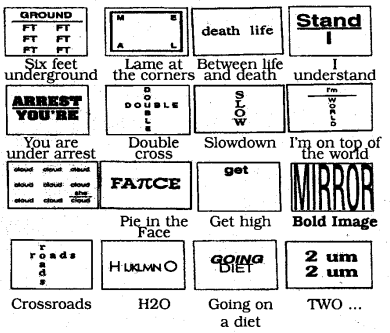
Louis Pasteur, Conqueror of Disease Summary in English
Louis Pasteur was born to a tanner who had worked In Napoleon’s army and had been honoured by him. Louis was born in France.
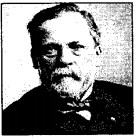
He studied Chemistry and became a Chemistry Professor. His wife was also his assistant during experiments.
Louis devoted his whole life to the study of bacteria which are present everywhere – air, water, soil, bodies of animals and plants. Some of them are harmful and some very useful.
Louis discoveries helped common people of his country carry on their professions of brewing, breeding silk worms and keeping cows.
When Pasteur was appointed as Head of a College of Science in Lille, a busy manufacturing town, he was happy because now he could help people with problems in their professions. At that time, people did not have a clear understanding of yeast and germs.
Pasteur carried out many experiments to prove that germs were carried in the air and could infect other things that came into contact with them. His experiments with a bend in the long tube of a soup bottle and many bottles of soup opened in different places, proved that air is full of dust particles and germs are carried by this dust.
Pasteur made his process of ‘Pasteurization’ popular by showing that by heating wine or milk to a temperature of 50 or 60 degrees centigrade, the germ in them was made harmless.
Pasteur founded the branch of science called ‘Bacteriology’ and studied for 3 years the cause of a disease ruining the silkworm industry.
When Pasteur realized that a cow could not have anthrax twice, he thought of injecting very weak old germs to cows or sheep to make them immune from anthrax. He demonstrated that this could be done so by experimenting in public with two groups of sheep, goats, and cows. The ones which were injected with weak germs survived, whereas the other group which hadn’t been injected died.
Pasteur showed that inoculation with weak germs worked with rabies too by injecting weak rabies germs into a rabies-affected boy.
Pasteur’s work help soldiers in the First World War stay healthy even while fighting in unhealthy places.
Pasteur was honoured by the French Government, and his memory is still honored at the Institute Pasteur in Paris where bacteriology is studied by men of all nations.
Pasteur’s 70th birthday was celebrated as a national festival. He died in 1895 at the age of 75.
Pasteur felt that the future belonged to those who shall have done the most for suffering humanity. He told youngsters that they would feel supreme happiness only when they contributed to the progress and welfare of humanity.
Louis Pasteur, Conqueror of Disease Summary in Kannada
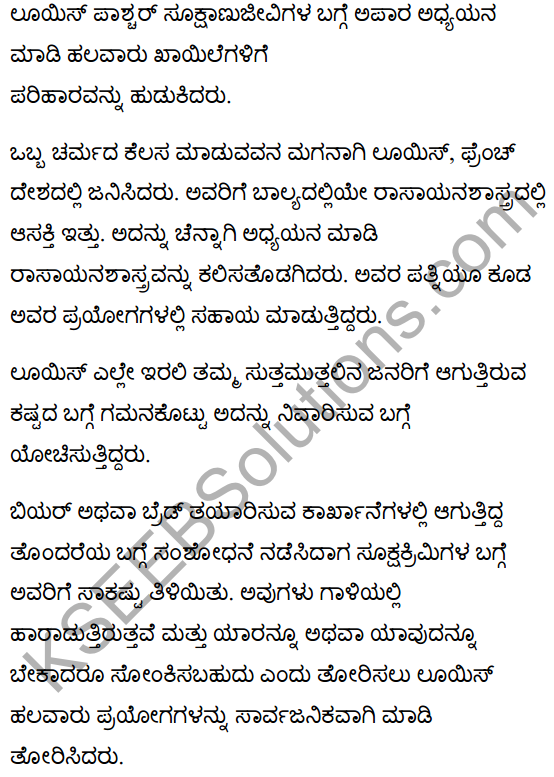
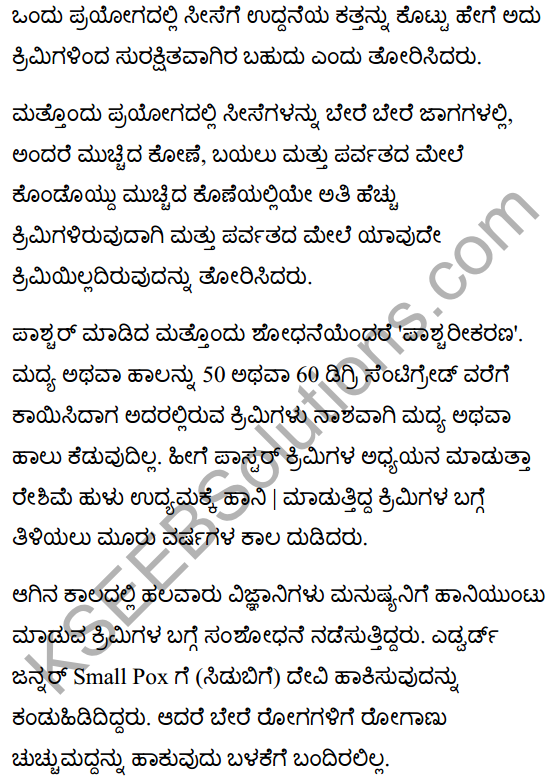
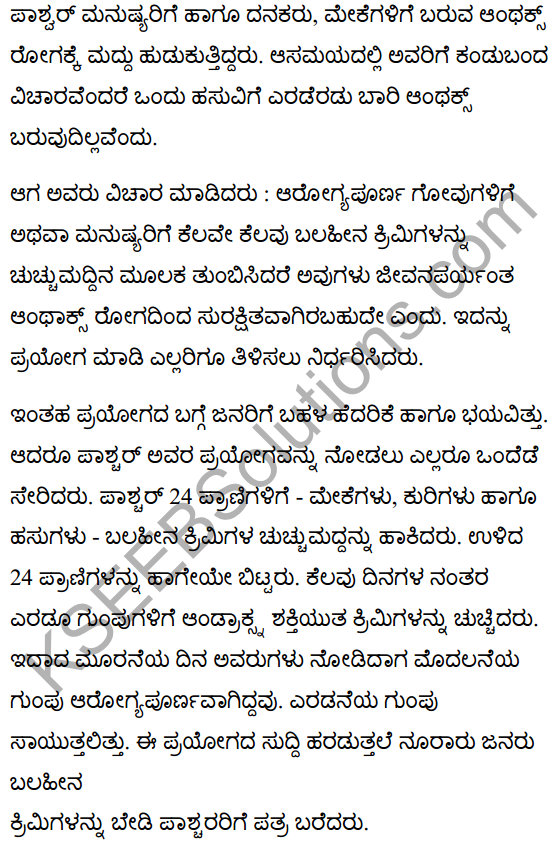
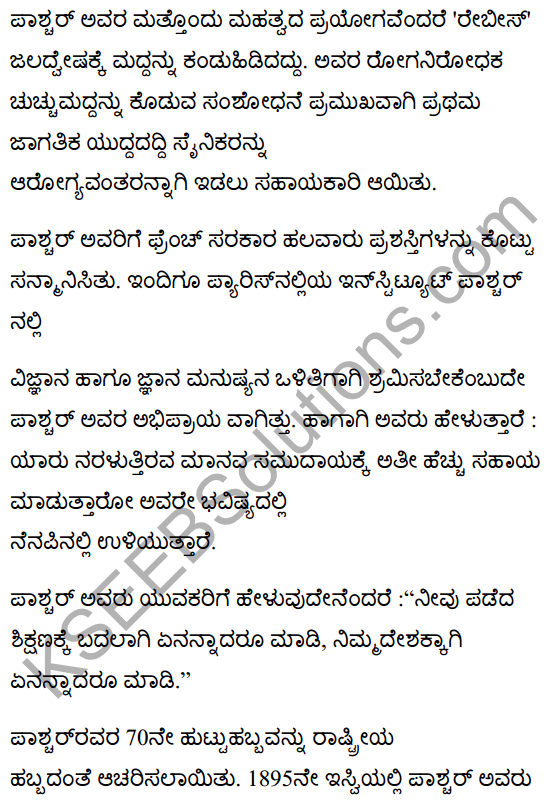
Hope all the information given regarding Karnataka Class 10 English Chapter 4 Louis Pasteur, Conqueror of Disease will help you to get good knowledge. For any queries, you can contact us and clear your doubts. Connect with us using the comment section. Also, we love your feedback and review. Get your Chapter Wise Karnataka Secondary Education Examination Board Class 10 Textbook Solutions for English PDF start learning for the exam.
